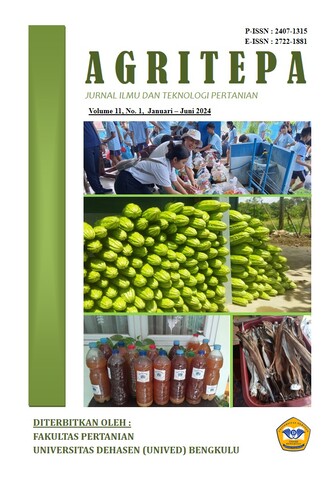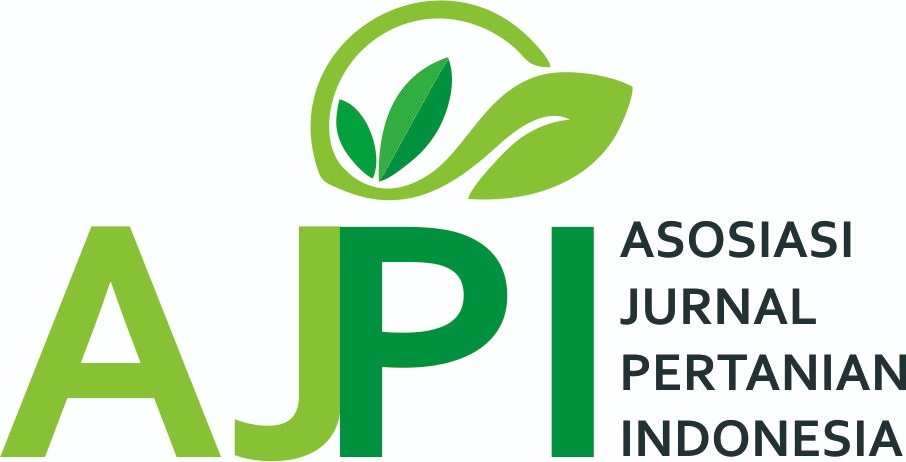Soaking Salt Solution Increases Moisture Content, Ash Content, Starch Content, Decreases Solubility and Swelling Power Of Banggai Yam Flour
flour; salt; soaking; yam Banggai
Abstract
Purpose: This study aims to investigate the effect of salt solution (NaCl) soaking on yam, focusing on food safety, organoleptic quality, and changes in chemical composition during the soaking process. Methodology: The method used was a factorial Complete Random Design with the following treatments: P0 = no treatment; P1 = soaking in 10 g/liter salt solution; P2 = soaking in 30 g/liter salt solution; P3 = soaking in 50 g/liter salt solution. Each treatment was repeated three times, resulting in 12 observation units. Results: The results indicated that higher salt solution concentrations led to increased water, ash, and starch content, while the solubility and swelling power of yam flour decreased. Findings: The study found that salt soaking positively affects the preservation and quality of yam by inhibiting pathogenic microorganisms and slowing down tuber rot. The increased concentration of salt solution was directly proportional to the increase in water, ash, and starch content. Novelty: This research provides new insights into the effects of salt soaking on yam, particularly on its chemical composition and potential benefits for food preservation. Originality: The study offers a detailed analysis of how different concentrations of salt solutions affect the quality and chemical properties of yam, contributing to the understanding of its implications for food safety and health. Conclusions: Soaking yams in higher concentrations of salt solution enhances their preservation by increasing water, ash, and starch content, while reducing solubility and swelling power. Paper Type: Empirical Research Paper
Keywords: Flour; Salt; Soaking; Yam Banggai
Downloads
References
Adebowale, K. O., Afolabi, T. A., & Olu-Owolabi, B. I. (2006). Functional, physicochemical and retrogradation properties of sword bean (Canavalia gladiata) acetylated and oxidized starches. Carbohydrate Polymers, 65(1), 93–101.
Afidin, M. N., Hendrawan, Y., & Yulianingsih, R. (2014). Analisis Sifat Fisik dan Kimia pada Pembuatan Tepung Umbi Uwi Ungu (Discorea alata), Uwi Kuning (Discorea alata) dan Uwi Putih (Discorea alata). Jurnal Keteknikan Pertanian Tropis Dan Biosistem, 2(3), 297–303.
Amar, A. A., Kusnandar, F., & Budijanto, S. (2021). Karakteristik Fisikokimia Tepung Ubi Banggai dan Aplikasinya Dalam Beras Analog. Jurnal Mutu Pangan : Indonesian Journal of Food Quality, 8(1), 43–52. https://doi.org/10.29244/jmpi.2021.8.1.43
AOAC. (1990). Official methods of analysis. In Foods Composition Additives, Natural Contaminants (Vol. 2, pp. 777–800). AOAC Arlington, VA.
Basrin, F., & Babe, T. (2019). Subtitusi Tepung Terigu Dengan Tepung Ubi Banggai (Dioscorea spp) Terhadap Mutu Organoleptik Biskuit. Jurnal Pengolahan Pangan, 4(1), 33–38. https://doi.org/10.31970/pangan.v4i1.23
Boleng, F., Anggraeni, F. D., Sumaryati, E., & Suprihana. (2022). Pengaruh substitusi tepung ubi kayu dengan campuran tepung kacang hijau dan tepung kacang kedelai terhadap kualitas gizi tiwul instan. Prosidia Widya Saintek, 01(01), 69–76.
BSN. (2009). SNI 3751:2009 Tentang Tepung terigu.
Chaniago, R. (2016). Subtitusi Tepung Terigu Dengan Tepung Ubi Banggai (Dioscorea) Dalam Pembuatan Mie. Jurnal Aplikasi Teknologi Pangan, 5(2), 34–37. https://doi.org/10.17728/jatp.v5i2.131
Chaniago, R., Lasamadi, R., & Madina, N. (2022). Karakteristik pati dan proksimat dari dua jenis ubi Banggai (Dioscorea alata) terhadap lama dan macam perendaman. Jurnal Agercolere, 4(1), 35–43. https://doi.org/10.37195/jac.v4i1.155
Hudi, L., Budiandari, R. U., dan Sari, L. N. . (2023). Sifat fisikokimia tepung umbi kimpul ( Xanthosoma sagittifolium ) termodifikasi metode fermentasi. Jurnal Teknologi Pangan, 14(1), 98–104.
Kurniawan, R. (2022). Pengaruh Tingkat Konsentrasi Larutan Garam Pada Pembuatan Telur Asin Dengan Metode Basah Terhadap Kualitas Fisik Dan Total Mikroba. In Fakultas Peternakan Universitas Jambi (Issue 8.5.2017). Universitas Jambi.
Kusnandar, F., Mutmainah, M., & Muhandri, T. (2021). Karakteristik Fisikokimia Pati Ubi Banggai (Dioscorea alata). AgriTECH, 41(3), 220. https://doi.org/10.22146/agritech.52535
Marlina, L., & Meilana, Y. (2023). Pengaruh Konsentrasi Garam Dapur dan Garam Himalaya Terhadap Masa Simpan Tahu. Pasundan Food Technology Journal, 10(1), 1–7.
Medikasari, M., Nurdjanah, S., Yuliana, N., & S, N. L. C. (2012). Sifat Amilografi Pasta Pati Sukun Termodifikasi Menggunakan Sodium Tripolifosfat. Jurnal Teknologi & Industri Hasil Pertanian, 14(2), 173–177.
Prasetyo, H. A., & Winardi, R. R. (2022). Proses Pembuatan Tepung Komposit dari Tepung Terigu dan Tepung Umbi-umbian Hasil Fementasi. Jurnal Agroteknosains, 6(2), 34–48.
Ramdhiana, efitria F., Asmanur Jannah, & Wibaningwati, D. B. (2020). Pengaruh Perlakuan Perendaman Terhadap Karakteristik Tepung Talas Bogor (Colocasia esculenta L. Schott) pada Klon yang Berbeda. AGRISINTECHJournal of Agribusiness and Agrotechnology, 1(2), 58–68.
Solikhah, N., Sri Haryati, & Aldila S.P. (2018). Pengaruh Lama Perendaman Larutan Garam Terhadap Sifat Fisik dan Kimia pada Pembuatan Tepung Pedada (Sonneratia caseolaris). Jurnal Mahasiswa, Food Technology and Agricultural Products, 1–13.
Suharti, S., Sulastri, Y., & Alamsyah, A. (2019). Pengaruh Lama Perendaman dalam Larutan NaCl dan Lama Pengeringan Terhadap Mutu Tepung Talas Belitung (Xanthosoma sagittifolium). Pro Food, 5(1), 402–413. https://doi.org/10.29303/profood.v5i1.96
Suleman, S. M., Budiarsa, I. M., Dhafir, F., & Sulfianti, S. (2021). Hubungan Kekerabatan Varietas Ubi Banggai (Dioscorea sp.) Di Sulawesi Tengah Berdasarkan Karakter Fenotipik. JST (Jurnal Sains Dan Teknologi), 10(1), 128–140. https://doi.org/10.23887/jstundiksha.v10i1.30274
Suparthana, I. P., & Putra, I. N. K. (2023). Pengaruh Suhu Perendaman Dalam Larutan Garam Terhadap Kandungan Kalsium Oksalat Tepung Keladi ( Xanthosoma Sagittifolium ). Itepa: Jurnal Ilmu Dan Teknologi Pangan, 12(1), 56–65.
Thirayo, Y. S., Apaladu, L., Sattu, M., Lalusu, E. Y., Bidullah, R., Syahrir, M., & Monoarfa, Y. (2022). Kandungan Vitamin C dan Mineral Zinc pada Ubi Banggai Jenis (Dioscorea Alata) di Kabupaten Banggai Kepulauan Tahun 2022. Buletin Kesehatan Mahasiswa, 1(September), 1–7.
Wardani, R. K. (2022). Penurunan Kadar Kalsium Oksalat Pada Umbi Porang Dengan Variasi Waktu Kontak, Suhu Dan Volume Larutan Sari Buah Belimbing Wuluh. Journal Pharmasci (Journal of Pharmacy and Science), 7(2), 85–89. https://doi.org/10.53342/pharmasci.v7i2.285
Wardani, R. K., & Handrianto, P. (2019). Reduksi Asam Oksalat pada Umbi Porang dengan Larutan Asam (Issue 1). www.penerbitgraniti.com
Wijaya, J., & Purwanto, M. G. M. (2023). Pengaruh suhu perendaman dalam larutan NaCl dan ketebalan chips umbi gembili (Dioscorea esculenta. L) sebagai sumber karbohidrat. Teknologi Pangan : Media Informasi Dan Komunikasi Ilmiah Teknologi Pertanian, 14(1), 3624. https://doi.org/10.35891/tp.v14i1.3624
Yuliansar, Ridwan, & Hermawati. (2020). Karakterisasi pati ubi jalar putih, orange, dan ungu. Saintis, 1(2), 1–13.
Yusnita, M. (2020). Asam, Basa, dan Garam di Lingkungan Kita (H. Hardinah (ed.)). Alprin.
Yusuf, Sahiri, N., & Madauna, I. (2015). Pertumbuhan Dan Hasil Jenis Ubi Banggai ( Dioscorea spp ) Pada Berbagai Pupuk Organik. Agrotekbis, 3(5), 555–563.
Zarnila, Ansharullah, & Hermanto. (2021). Pengaruh Lama Perendaman terhadap Karakteristik Proksimat dan Fisikokimia Tepung Umbi Gadung (Dioscorea hispida Dennst ). J. Sains Dan Teknologi Pangan, 6(5), 4436–4449.
Copyright (c) 2024 Ramadhani - Chaniago, Darni Lamusu, Fitriani Basrin (Author)

This work is licensed under a Creative Commons Attribution-ShareAlike 4.0 International License.
Author retains the copyright and grants the journal the right of first publication of the work simultaneously licensed under the Creative Commons Attribution-ShareAlike 4.0 License that allows others to share the work with an acknowledgement of the work's authorship and initial publication in this journal













